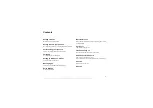
8
6 Calculation of level
7 Mode of operation
The pressure of the medium acts on the keramic sensor which is deflected to transmit the pressure to the piezo-resistive
bridge in the measuring sensor. Every sensor is compensated for changes in temperature and operates within a wide tem-
perature range. The output signal of the sensor is fed to an electronic circuit which converts it into a standard current output
(4...20 mA). The hydrostatic pressure which is proportional to the submersion depth acts on the diaphragm of the sensor.
This pressure is compared with the atmospheric pressure which acts on the other side of the sensor by means of the vent
pipe in the connecting cable (at relative pressure).
8 Installation
The level pressure transmitter is installed hanging downwards on the cable. In moving media, the transmitter must be fixed
to prevent measuring errors. This can be done with a guide tube. Make sure that the inlet openings on the protective cap of
the level pressure transmitter are not soiled in order to guarantee perfect functioning.
9 Calibration
The transmitter has been calibrated to the measuring range at the factory and cannot be re-calibrated.
h
h - Fluid level
- Measurement reference height
A - Distance from protection cover to the position of measuring diaphragm
B - distance from beginning of thread to the position of measuring diaphragm
(without protection cover)
General level with relative pressure sensor:
Legende:
h
level [m]
ρ
density of media [kg/m
3
]
g
acceleration of fall 9.80665 [m/s
2
]
∆
p
measured relative pressure [Pa]




































